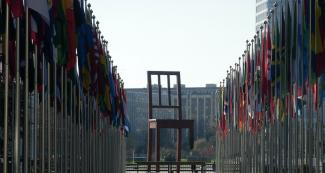Statement to the BTWC Meeting of the States Parties, Geneva, 5 December 2005
STATEMENT TO MEETING OF THE STATES PARTIES TO THE CONVENTION ON THE PROHIBITION OF THE DEVELOPMENT, PRODUCTION AND STOCKPILING OF BACTERIOLOGICAL (BIOLOGICAL) AND TOXIN WEAPONS AND ON THEIR DESTRUCTION, GENEVA, MONDAY, 5 DECEMBER 2005
Mr Chairman, Distinguished Representatives, Ladies and Gentlemen,
I am Animesh Roul, Research Fellow at the Society for the Study of Peace and Conflict, New Delhi, India, and I am pleased to address you today on behalf of my organization, prior to the commencement of the third and final Meeting of State Parties focusing on the content, promulgation and adoption of “codes of conduct for scientists.”
My organization, the Society for the Study of Peace and Conflict aspires to carry forward research and advocacy on arms control and non-proliferation issues amongst other urgent concerns of our time. Although the region to which we belong and in which we operate is obsessed with all matters related to nuclear weapons, SSPC, a relative newcomer, dares and cares to undertake research on biological weapons and emerging and remerging infectious disease as two of its core areas of study.
I would like to direct your attention towards some of SSPC’s work undertaken in the current year: firstly, a Fact Sheet on BTWC on its completion of thirty years and a Dialogue paper on the occasion were well received in India and abroad; secondly, SSPC is engaged in building a database regularly monitoring BW events and events related to both natural and deliberate disease spread. In the coming year, the year of Sixth BTWC Review Conference, SSPC also plans to publish a book devoted to BW disarmament as well as a Special Issue in its in-house print journal (South Asia Journal of Conflict and Terror) on biological terrorism. Our underlying aim is to draw out the BW issue into the public domain to both raise awareness and to initiate a dialogue within the South Asian civil society against biological weapons – the most insidious weapons known to mankind.
Mr Chairman,
The meeting scheduled for this week will focus on the aforesaid Codes of Conduct for Scientists and will certainly assess the ‘Meeting of Experts’ that took place earlier this year in mid-June on the same issue. It is now a commonly accepted that advances in science and technology can have both positive and negative effects on our societies and the protagonists are our scientists. The vital question which grapples all of us today is “what if the Savior Scientists become hostile?”
Mr Chairman,
The fear articulated by Joshua Lederberg, Nobel laureate, during the very outset of the biotechnology revolution in the 1970s seems to be a reality now. Lederberg expressed his concern when he feared that it might be possible to create infectious agents against which there would be no defense through biotechnology. Through biotechnology it is now possible that nonpathogenic microorganisms can be transformed into pathogenic microorganisms and, by altering the antigenic structure of a pathogen, it would be easy to penetrate the human immune system. By the latter method a terrorist group could unleash a disease into a population previously vaccinated.
It’s beyond doubt that the nature and scope of bio-warfare has changed systematically due to the revolution in the life sciences. The crux of it lies in the rapid growth of the biotechnology and its extensive applications in every sphere of life. Although it offers many social and economic benefits, the flip-side of biotechnology is one containing horrifying possibilities especially when the know–how and materials relevant to biological weapons are becoming widespread and get a pretext due to its dual-use character.
The progress in molecular biotechnology and the provisions of the Biological Weapon Convention (BTWC) for peaceful activities are the cause of much concern as both the Geneva Protocol of 1925 and BTWC lack verification measures. However, the call for a national ‘oversight’ mechanism for the security and genetic engineering of pathogens, and the appeal to devise a framework for bio-scientists in the form of a code of ethical conduct could cast a spell on the BTWC mechanism, if succeeded in totality.
Mr Chairman,
Although the study of the threats posed by modern biotechnology is still very hypothetical, it is certain that any loopholes in the BTWC in any form can serve as a cover for rogue scientists and states to carry out research and development of offensive warfare agents using biotechnology, and worse still, nanotechnology, as a pretext. In light of this danger, “Codes of conduct” need to be in place for all scientists irrespective of the nature, place and scope of their jobs.
Thank you, Mr Chairman.
UNOG Database Link for Full Text in PDF.
